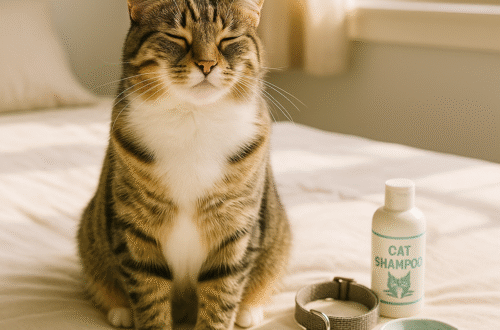Have you ever been surprised by your sweet cat suddenly hissing, swatting, or even trying to bite? Cat aggression can be scary and stressful, both for you and your feline friend. Aggressive behavior often happens when a cat feels threatened, scared, or in pain but the good news is, with the right approach, you can help your cat calm down and regain trust.
In this guide, we’ll cover five proven tips to calm an aggressive cat safely, so you can enjoy a peaceful, happy home again.

1. Identify the Cause of Aggression
Before you can calm your cat, you need to understand why they’re acting aggressively. Cats don’t lash out for no reason their behavior is a form of communication.
Common causes include:
- Fear or anxiety: Loud noises, new people, or sudden movements can trigger fear-based aggression.
- Territorial behavior: New pets or unfamiliar cats in the area can make them defensive.
- Pain or illness: Cats in pain may swat or bite when touched.
- Overstimulation: Too much petting or handling can lead to sudden “petting-induced aggression.”
Tip: Watch your cat’s body language. Flattened ears, dilated pupils, and a flicking tail are early signs they’re feeling threatened. By spotting these signs early, you can step back and avoid triggering a full-blown aggressive episode.

2. Give Your Cat Space and Time
When a cat is aggressive, forcing interaction will only make things worse. Your first step is to back away and give them space to calm down on their own. Cats are naturally independent animals, and they need a safe zone where they feel secure.
Here’s what you can do:
- Step back calmly: Avoid yelling or making sudden moves.
- Create a safe space: A quiet corner with a cozy bed, blanket, or cat tree can help.
- Avoid direct eye contact: Cats see staring as a threat instead, slow blink or look away.
- Limit handling: Wait until your cat approaches you on their own.
Giving your cat the time and freedom to cool down reduces stress and prevents the aggression from escalating. Once they feel safe again, they’ll slowly start to trust you and relax.

3. Use Calming Tools and Techniques
Once your cat has a safe space, the next step is to help them relax using proven calming techniques. Cats respond well to certain sensory triggers that can lower their stress and reduce aggressive behavior.
Here are some effective methods:
- Use pheromone diffusers or sprays: Products like Feliway release synthetic pheromones that mimic a cat’s natural calming signals.
- Play soft, soothing music: Gentle instrumental sounds or nature music can help calm a stressed cat.
- Slow blinking and gentle movements: Cats communicate trust with slow blinks. Try blinking slowly at your cat instead of staring.
- Avoid overstimulation: Keep the environment calm no loud TVs, vacuum cleaners, or sudden disturbances.
Pro Tip: Place a pheromone diffuser in your cat’s favorite room and keep the lighting soft to create a relaxing vibe. This can make a huge difference in reducing aggression over time.

4. Reward Calm Behavior with Positive Reinforcement
Cats respond best to positive reinforcement. Instead of punishing aggressive behavior, which can make things worse, reward your cat when they show calm and relaxed behavior.
Here’s how to do it effectively:
- Offer treats when they’re calm: Wait until your cat is lying quietly or approaches without aggression, then reward them with a small treat.
- Use gentle petting: Start with slow, light touches on their head or under the chin areas most cats enjoy.
- Incorporate play sessions: Reward calm moments by engaging with a feather wand or toy, keeping interactions fun and positive.
- Be consistent: Over time, your cat will associate calm behavior with rewards, which encourages trust and reduces aggression.
Important: Never punish your cat for aggression. Yelling, spraying water, or hitting will only make them more fearful and defensive.

5. Consult a Vet or Behaviorist if Needed
If your cat’s aggression doesn’t improve even after trying all the calming techniques, it’s time to seek professional help. Persistent aggression can sometimes be linked to underlying medical issues or deep-rooted behavioral problems.
Here’s what you should do:
- Schedule a vet check-up: Pain, infections, or thyroid issues can trigger sudden aggression.
- Consult a feline behaviorist: They can observe your cat’s environment and suggest tailored strategies.
- Follow professional guidance: Combining medical and behavioral advice ensures long-term improvement.
Getting expert help early can prevent future incidents and keep your home peaceful for both you and your cat.

Conclusion
Dealing with an aggressive cat can be stressful, but with patience, understanding, and the right approach, you can rebuild trust and create a safe environment.
Start by identifying the cause, give them space, use calming tools, reward good behavior, and don’t hesitate to seek professional help if needed. Over time, your furry friend will learn to feel safe and loved again.





